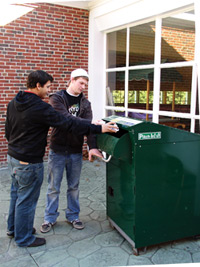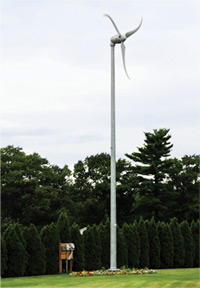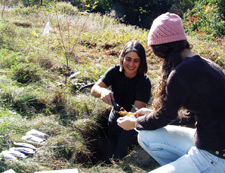In the schools and colleges of Wellesley and Weston… Sustainability is the lesson of the day!

Meadowbrook School’s Caryn Shield with young environmentalists
Let’s begin on a controversial note. You may be of a mind that global warming and environmental activism is a bunch of baloney—or you may not. Politics aside, one can use statistics to “prove” all sorts of things and the ones you may be paying attention to—if the topic is of any interest—may have persuaded you that all the commotion is just not worth your time. Or they may not.
But consider the news of recent months. Whatever went wrong on that BP drilling rig out in the Gulf—what some people are calling “the revenge of the dinosaurs”—has had a devastating effect on the marine life and bayous of Louisiana’s coastal communities. But it may also have caused a broad shift in public perception (including yours and mine) that the price of deep-water drilling goes beyond our latest oil bill, or even daily variations in the price of gasoline in Wellesley Hills—and that we need real change in the way we make and use energy. Or it may not.

BigBelly® is a solar-powered trash bin that sits outside Trim Dining Hall. The business was founded by MBA Babson alumnus Jim Poss.
Brian Donahue, the noted environmentalist and native of Weston, recently cast the BP blowout in a slightly different light. At a Massachusetts Historical Society forum on the history of regional design he asked, assuming a deadpan manner that resonated with irony, “What is the difference between venting millions of barrels of crude oil into the Gulf of Mexico or willingly pumping millions of gallons of refined oil in the form of gasoline into automobiles—and then spewing vast amounts of car exhaust into the atmosphere, every day?”A surprisingly large group right here in Wellesley and Weston—its numbers are in the thousands, actually—is keenly aware of the implications of environmental degradation (and not just the kind represented by catastrophic oil spills and unrestrained use of fossil fuels) and is working energetically to do something about it.
At your Kitchen Table
You know some of that group, because a couple of its members may be sitting at your kitchen table right now, doing their homework. Others are living in the dormitories of local prep schools, or at area colleges like Babson, Wellesley, and Regis. They are, of course, your children.
At virtually every educational institution in Wellesley and Weston—from the elementary grades to undergraduate and graduate schools—environmentalism is the topic of the day. Faculties and administrations are in on this too, from school superintendents and college presidents right down to custodians and grounds crews. They’re responding to calls from national, state, and local bodies, legislatures, executive authorities, and educational associations to do something substantive about the environment.
Sustainability is about managing “waste streams” and “carbon footprints,” about “greening” communities and understanding the natural world. And in Wellesley and Weston, entire school buildings and college campuses have become teaching laboratories on this topic with curricula re-written to integrate environmentalism in the classroom, student clubs formed, and campaigns launched.
Babson College
If any institution in Wellesley can lay claim to maintaining a “culture of sustainability,” it’s Babson. With an administration and facilities department dedicated to achieving tangible sustainability goals, the notion of a green campus is supported by undergraduate and graduate clubs, major sustainability events, and facilities design and management practices.

Tomasso Hall Bell Tower is a focal point after dark, enhanced by LED lighting.
Conor Carlin, a native of Northern Ireland, freshly minted MBA, and former co-president of the Babson Energy and Environmental Club, sees business taking a serious approach to sustainability. Citing authors like Paul Hawken, whose The Ecology of Commerce(Harper Business, 1993) has been influential on his thinking, Carlin is prototypical of a new generation of entrepreneurs focused on finding “the green in green.”
“The more I look into this,” he says, “I can see business is taking a serious approach. There are shareholder movements building for sustainability in corporate investment.” An environmental conference Carlin and his classmates organized last March drew 375 attendees. “For me it was a justification of what I believe,” says Carlin, whose career trajectory is wrapped around biodegradable plastics. “We have business leaders showing us how positive financial results can be achieved at the bottom line by running a business in a sustainable manner.”
More and more courses and on-campus initiatives support such thinking.
Ensuring Babson College practices green while teaching green is Shelly Kaplan, the college’s vice president for facilities and grounds. Kaplan and his team of six facilities managers have a sharp focus on sustainability. Their job, along with their counterparts in 670 other US colleges and universities, is to go carbon neutral, and they’re serious about it.
Talk among the group turns to some of the 200 sustainability programs currently in place or under active consideration at Babson: “We’re making our own bio-diesel, retrofitting lighting receptacles, reducing power consumption with remote monitoring, and eliminating synthetic fertilizers in our landscape,” the group offers, picking among a host of sustainability initiatives. “We’ve just launched a new program to make sustainability a focus of everything we do,” says Kaplan, “to look at everything in terms of long-term impact.”

A wind turbine, installed and dedicated in spring 2008, sits adjacent to the Upper Athletic Fields. The project was spearheaded by MBA students in the Energy and Environmental Club and fully supported by the College and Babson Facilities.
Wellesley College
Wellesley learned sustainability the hard way some years ago when it found itself engaged in a two-year cleanup of an old paint mill dating from the 19th century. Located in the Northwest corner of the campus, the cleanup effort resulted in the creation of a magnificent nature preserve featuring cascading waterfalls and an enticing wooden walkway in the rush-dotted wetlands of Lake Waban.
But the cleanup has been only part of the Wellesley College story according to Pat Willoughby, the college’s Director of Sustainability. “We’ve reduced our energy consumption by 21 percent since 2004,” he notes. “By using gas-driven co-generation systems to produce our own electricity, heat, and air conditioning, we’re reducing the carbon impact that would accompany oil or coal use, while cutting costs.”
A variety of other programs at Wellesley have reclaimed an old parking lot (as recently reported inTIME magazine), increased on-campus wetlands, cut down on the college’s waste stream, and limited landscaping water use. But perhaps the most intriguing aspect of Wellesley’s sustainability programs lies in a directed study program run by faculty member Kristina Jones. “Our students have designed an ‘Edible Forest Garden,’” she says, “to be planted in a small meadow adjacent to the college observatory.”
Wellesley College students are creating a half-acre, low- to no-maintenance planting area populated by mulberry, jujube, and sickle pear trees, along with supporting “plant guilds” of wild onion and garlic—all designed to hold off “bad” bugs and attract “good” ones.

The Lulu Chow Wang Campus Center at Wellesley College
Carly Gayle, a Wellesley freshman explains: “One of the biggest parts of sustainability is food. We want to show people a completely different way to grow it that works within a natural ecosystem. We’re moving back to the way Native Americans farmed—finally, after hundreds of years.”
Meadowbrook School
Students at this independent day school for grades kindergarten through eight on Weston’s eastern border can count themselves lucky. With faculty member Caryn Shield to shepherd them into the brave new world of sustainability, their breadth of environmental studies and best practices is second to none. In her first year at the school, she guided a group of eighth graders to Costa Rica, where “something clicked for me,” during visits to a sustainable farm and residential community.
Back at school, she began to explore how gardening, cooking, and service to others could all be integrated into learning programs that take advantage of free time, like recess, and devote it to the environment.
“We like to start young,” says Shield. “In our after-school class our kids recycle, compost, and garden…It shows kids where our food comes from and how to build an appreciation for real nutrition and local agriculture.”
She points with pride to a middle school green team, an annual “Sustainability Week” focused on keeping track of food waste statistics, and a “Lights Off Initiative” in which Meadowbrook students tracked energy consumption around the school. Not content with her already formidable knowledge of the environment and how to share it with her students, Shield is pursuing graduate studies in the field.
Weston Public Schools
Superintendent Cheryl Maloney finds personal inspiration for her own ideas about sustainability and the environment in her vacation travels. “You stand at the edge of the Grand Canyon and you cannot help but be in awe,” she says, taking time from a busy day to personally chat about Weston’s sustainability programs and her own involvement in them.
“We have a green team in every Weston school,” she says. “This year’s focus was on reducing energy use, which resulted in significant cost savings over prior years. The kids have been phenomenal, with Country, Field, and Woodland Schools all taking firsts in various years. The winners get an ice cream party.”

An enticing wooden walkway beckons visitors to explore Wellesley College’s magnificent nature preserve.
“The environment is woven into a variety of our disciplines, including government and social studies, with a focus on individual responsibility. We teach environmental sciences at the high school, but achieving tangible results can be challenging. One goal—to reduce paper usage—is proving hard to measure.”
Dana Hall School
Horseback riding and musical proficiency still count at “Dana,” but sustainability grows in importance, daily, thanks to the teacher-librarian team of Meera Shah and Sam Musher. In small, yet important, ways the two have led a low-key sustainability effort at this venerable preparatory school for young women in Wellesley. “We went trayless in the dining center to save on water and energy and saved 50 percent on food waste using a simple bucket system,” says Meera.
“It took a lot of education and student presentations, but it’s a good example of bottom-up change. Our Green Team, especially among our middle school students, is motivated and self-directed and our upper school has set up over twenty recycling centers around campus. We’ve reduced our rubbish removal expenses,” Meera adds.
Wellesley High School
If there is a crown jewel in the diadem of sustainability efforts in Wellesley and Weston, it may the town’s new high school facility. Joel Seeley, an architect and leader of the school’s design team, points to the sustainability features of the building, which is budgeted at $130 million.
“We’re pursuing three main themes,” he says, “including day-to-day operating features, how the building works as a whole in the larger scheme of things, and how our ‘design for sustainability’ integrates into the school’s educational curriculum.”

The walking paths around Lake Waban at Wellesley College.
Seeley, after reeling off a score of insulating and building materials and design standards, all based on sustainability, observes a “Data Acquisition System” near the school entrance that will monitor temperature, energy use, water savings, and electrical generation.
The new facility will be a marvel of advanced technology, including a “green roof” supplemented by solar panels, and geothermal wells for heating and cooling administrative offices. But great teaching is the order of the day at WHS, too, which has inspired an exceptionally high level of student engagement that has brought sustainability to the fore in ways that might not be possible elsewhere.
“Green evangelism” would not be too strong a way to describe the promotional posters, programs, and learning activities that have proliferated throughout WHS in recent years.
Teacher Theresa Green has been cited for her dedication and imagination, which has resulted in a “green certification” of classrooms and offices in the current high school, end-of-the-year cleanups, an environmental fair, and a host of other consciousness-raising programs, including an Earth Week celebration. “Most importantly, we’ve been active in advocating for green features in the new high school,” Green says, “to ensure it will be environmentally friendly.”
Regis College
Founded in 17th century France and first established in Boston in 1873 by four teaching sisters from the order of St. Joseph, the order’s establishment of a college in Weston named for one of its local founders makes sense in terms of the environment, according to Walter Horner, director of Regis’s special programs. “Our commitment stems from the values of our founders,” he says. “Care for the earth is written into everything we do.”
“Sustainability and social justice are threaded through our curriculum,” he says, “and we’re busy developing a new environmental biology concentration. On the facilities side we’re installing new boilers, lighting, and water handling, along with a new recycling system. We’re paying close attention to the leadership of the New England Board of Higher Education, whose sustainability conferences we attend every six months.”

Wellesley College faculty member Kristina Jones working with a student in the “Edible Forest Garden.”
Mass Bay Community College
In 2007, Mass Bay president Carole Berotte-Joseph joined over six hundred of her colleagues who lead institutions of higher learning around the country and signed onto the “American College and Universities Climate Commitment.” Among the many initiatives resulting from this action were energy-saving programs overseen by Mass Bay’s facilities director, Marco Brancato.
“We’ve done a lot here in such areas as energy performance, recycling, and water management,” says Brancato, who has been looking after the college’s physical plant and operations since 2006. He points with pride to major savings in electricity through self-managed generation and bulb replacement, which takes Mass Bay off the Wellesley power grid at times when energy costs are at their greatest and reduces consumption.
From obsolete computer and used paper recycling to student clubs planting dogwoods this spring (“They look great and recycle carbon dioxide,” says Brancato), Mass Bay is working hard to manage itself sustainably.
Rivers School
Sustainability has a competitive edge at Rivers, whose Advanced Placement courses, conservatory program, and athletics put it and its 450 students squarely in the running as one of New England’s best prep schools in the area of academics. “Our ‘Footprint Focus Group’ is looking at our school environmental culture,” says science teacher Emily Stevens. “What we’re sorting out is the divide between consciousness and habit.”
Meanwhile, Rivers scored third in its division in the Northeast Day School Green Cup Challenge, a competition based on electricity use and carbon-producing energy reduction. “We’ve cut electricity use by 16 percent over the last three years, as measured in February,” says Stevens. Meanwhile, a student-led Environmental Action Committee is doing a sustainability survey and managing campus-wide cleanup days.

Bio-diesel fuel recycled from Babson’s kitchens and processed in the maintenance barn is used to fuel campus vehicles, including this snowplow.
Integrating Sustainability
From the Wellesley Natural Resource Commission, where Janet Bowser is shepherding multiple green programs to the town’s municipal power department, where director Dick Joyce is managing a variety of energy conservation programs, Wellesley is headed for a more sustainable future.
And isn’t that the way Weston’s Marion Case always wanted the future to be with her pioneering Hilltop Farm program, as did the visionary founders of the Weston Forest and Trail Association or Land’s Sake? Or think back to times past in Wellesley, where H.H. Hunnewell likewise saw to the creation of its parks and widespread plantings of shade trees and rhododendrons.
A Hunnewell cousin named Charles Sprague Sargent was the first director of Harvard’s Arnold Arboretum (since the 19th century a center of study for the growing of trees and shrubs) and a colleague of Frederick Law Olmsted’s, whose ideas led to the design of the Wellesley College campus.
In ways we cannot imagine, our children’s love and respect for the earth is going to be a major factor in their lives, because that is what they have learned in school. In Wellesley and Weston, sustainability is the lesson of the day. ![]()
Peter Golden writes about the social and natural history of local communities.
© 2010 Elm Bank Media | Beth Furman, Publisher | Beth@ElmBankMedia.com


recent comments